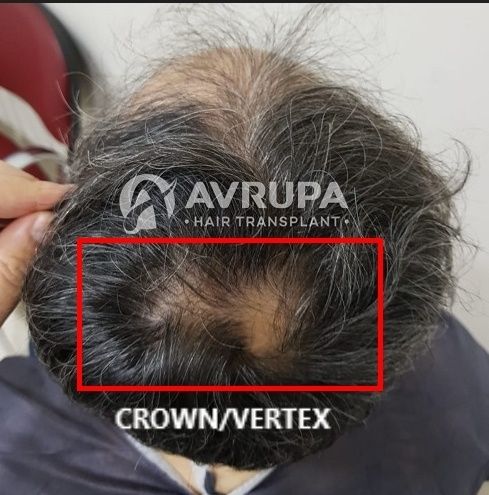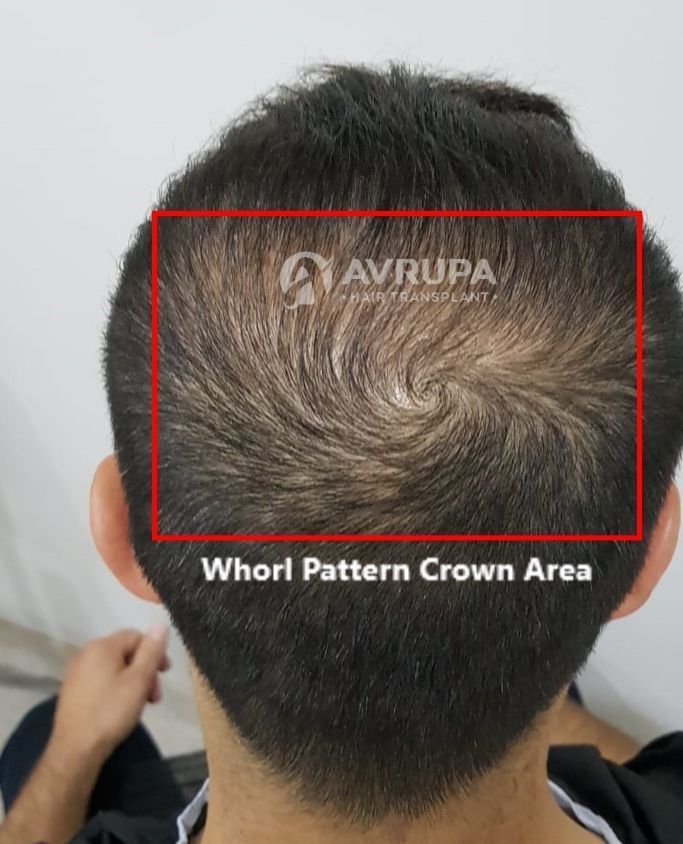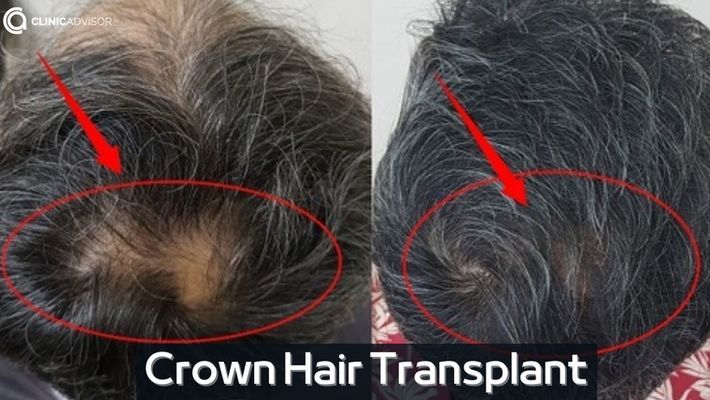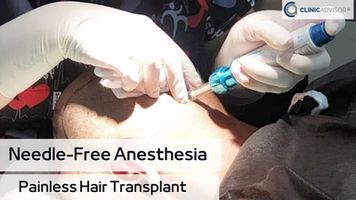Written by: Avrupa Hair Transplant Clinic
Hair transplant on the crown area is a surgical procedure that is used to restore hair in the balding or thinning vertex areas of the scalp.
This procedure has become increasingly popular in recent years, as more and more people are looking for ways to improve their appearance.
However, many people are still unsure about whether or not a crown hair transplant is worth it, and whether or not the transplanted hair will actually grow.
In this blog post, we will explore these questions and provide you with all the answers!
What is the Crown Area?
The crown area, aka the vertex area of the scalp, is the highest point at the top back of the head.
The hair in the vertex area is characterized by a spiral or whorl pattern where it grows in a clockwise or counterclockwise direction.
 Hair growth pattern in the crown area
Hair growth pattern in the crown area
This pattern is thought to be determined by genetics, and it usually remains consistent throughout a person’s lifetime.
While the vast majority of people have one vertex hair whorl, there are some people who have two known as the “Double Crown”.
Regardless of the exact pattern, the hair in the vertex area generally grows in a more uniform direction than the hair on other parts of the scalp.
Is Hair Normally Thinner at the Crown?
The natural swirl hair pattern and the direction of hair growth on the crown area are actually what make the hair look thinner and more transparent.
Even those who don’t suffer from Male Pattern Baldness will still have visible thinning at the crown due to this pattern.
 Whorl hair pattern in the crown area
Whorl hair pattern in the crown area
However, some people who suffer from androgenic alopecia will start noticing that their hair in the crown area is thinning and progresses to cause bald patches.
This is due to the miniaturization of hair follicles in the crown area.
How Does Hair Transplant for Crown Work?
Hair transplant for crown works by taking hair follicles from the donor region on the scalp and transplanting them into the balding or thinning areas on the crown.
The most common donor site is at the back of the head, as this is where hair usually remains thick even in those suffering from hair loss. And that’s due to its ability to resist the DHT hormone which causes hair loss.
The surgeon will first numb the back of the scalp with local anesthesia before extracting the individual hair follicles.
These follicles are then transplanted into micro-incisions made on the crown. Once transplanted, the hair follicles will start to grow new hair in a few months.
The skills of hair restoration surgeons are very important when dealing with the crown region.
They must have an artistic vision and the ability to follow the circular pattern of the crown hair to guarantee natural results.
Does Hair Transplant Work on Crown?
Crown hair transplantation is a highly effective treatment for those suffering from hair loss and baldness in the vertex area.
In most cases, the newly implanted hair will start to grow within a few months and will continue to grow for the rest of your life.
While the exact results will vary from person to person, you can expect to see a significant improvement in the overall appearance.
Yet, it’s important to know when is the right time to get a hair transplant for crown and if you are a good candidate.
Are You a Good Candidate for Crown Hair Transplant?
If you are suffering from hair loss or baldness in the crown area, then you may be a candidate for a crown hair transplant.
However, there are certain factors that must be taken into consideration when determining if you are a good candidate or not. Some of these critical factors include:
Your Age
One of the first things you will be asked about is your age. Age is a determining factor when deciding whether you are a good candidate for hair transplant on the crown or not.
You must be asking why?
Well, the reason is that proper planning based on a patient’s age is very crucial.
Because there is a big chance that young men who start having hair loss in the crown area before other regions will more likely develop hair loss in the frontal or mid-scalp areas at some point.
For that reason your hair transplant specialist will put this into consideration while determining your eligibility to have enough donor hair for future sessions.
Rushing into hair transplantation at an early age could consume your donor area which will limit your options to get a full coverage in case of more advanced hair loss.
The Extent of Your Hair Loss
When patients are experiencing hair loss in different regions, it’s important to determine the areas of higher priority.
Some patients may be more interested in covering the crown area first.
But from a surgeon’s perspective, the crown is less visible compared to the frontal area which is aesthetically more significant and the most visible part.
Thus, more attention must be focused on the frontal parts. So, in this case, if the grafts are not enough for the back top area at least the frontal area is covered.
The Density of Your Donor Hair
The donor region is where the hair grafts are taken from and the most resistant area to the DHT hormone.
Thorough planning of hair transplants is important to avoid overconsuming your donor site since it’s finite.
What does “finite” mean? You must be asking…
When we say that the donor area is finite it means that it has a limited number of hair grafts. And that the extracted follicles will not grow back again.
This is why a hair transplant surgeon must carefully plan the availability of hair grafts for future hair loss.
The best way to find out your eligibility is to get an initial consultation with a hair transplant clinic to discuss your specific case and treatment options.
How Many Grafts Are Needed for Crown?
The number of hair grafts you need for the crown area will depend on the size of the area and the extent of your hair loss.
As a rule of thumb, those who are just starting to experience thinning in the crown area will need fewer grafts than those who are balding or have large bald patches.
However, most people will need between 1,000 and 2,000 hair grafts for the crown area in order to achieve their desired results.
In general, the hair in the crown is not as dense as hair in other areas of the head, so more grafts may be needed to create a fuller look.
Ultimately, it is best to consult with specialized hair transplant surgeons to determine how many hair grafts are needed for your specific case.
It’s also important to note that due to the hair growth direction in the vertex area there will still be some thinning and this is not in any case related to hair thinning.
It actually has to do with the “Whorl Hair” pattern in that area. So, it’s always wise not to keep very high and unrealistic expectations.
What is the Cost of Hair Transplant for Crown?
The crown hair transplant cost can vary depending on a number of factors, including the surgeon’s fees, the clinic’s costs, and the number of grafts you need.
In general, you can expect to pay between $2000 and $7000 for a total of 1000 grafts or between $4000 up to $14,000 for a total of 2000 grafts in the USA.
However, the cost of hair transplant for crown in Turkey is not charged based on the number of grafts as they follow a fixed pricing policy. Which is actually reasonable since it will cost much less than if it was charged per graft.
For instance, you can get an all-inclusive package for crown hair transplant with the maximum number of grafts for $1850 up to $3000.
Are There Any Risks Associated With Hair Transplant for Crown?
As with any surgical procedure, there are some risks associated with a hair transplant on crown. These include bleeding, infection, itching, scarring, and numbness.
However, these risks are usually minimal and can be easily managed by your surgeon. In rare cases, people may experience what is known as “shock hair loss” which is a temporary loss of hair that typically occurs within a few weeks after the surgery.
Shock hair loss is usually caused by the trauma of the surgery and is not permanent. It is important to note that shock loss is different from the shedding that can occur after a hair transplant.
Shedding is a normal part of the hair transplant process and is not a cause for concern.
Why Does Transplanted Hair on Crown Take Longer to Grow?
A crown hair transplant will usually take longer to grow than a transplant in other areas due to slower blood circulation and fewer blood vessels.
In addition, the skin in this area is thicker, which makes it more difficult for the new follicles to take root. However, once they do start growing, they will look natural and will be permanent.
Another reason is that it could be due to the hair in the vertex area which grows in a more uniform direction.
This means that the implanted hair may not initially blend in as well as it would in other areas.
However, with time and proper care, the hair will start to grow and blend in with the existing hair on your crown. You can expect to see full results within 12-18 months.
Crown Hair Transplant Results
It can take some time for the new hair to thicken in the crown, but it usually starts to fill in within a few months.
The full results of the procedure may not be visible for up to 12 or 18 months, but most people see a significant improvement after 8-9 months.
In some cases, the hair may fall out shortly a couple of weeks after the procedure, but this is usually temporary and should not cause any long-term damage.
Once it starts to grow back, it will usually continue to do so for the rest of the person’s life.
Crown Hair Transplant Before and After
Here we’ll show you real-life examples of one of the previous patients who had a hair transplant in Turkey for the frontal and crown areas.
As we can see in the photos he obtained brilliant results. Although around 1000 grafts were implanted on that small bald spot on the crown, you can still see through the scalp.
 Crown hair transplant results
Crown hair transplant results
From here we can understand that the pattern of the crown is what gives this illusion of thinning while the maximum number of grafts were transplanted.
Why Do Crown Hair Transplants Fail?
Hair transplants for crown do not always fail, they are actually effective but must be handled and planned carefully.
Failure will happen only if it was conducted by an unprofessional and unskilled clinic. This could be due to poorly opening the incisions at wrong angles or opening incisions too deep that it disrupts the blood supply.
Lower hair density and being able to see through the crown are not signs of failure. Actually, these are very normal outcomes due to the nature of that area.
Factors Affecting Hair Density on Crown after Hair Transplantation
The recovery process after crown hair transplantation is almost the same as other areas of the scalp; however, there is a slight difference in terms of hair growth rate, thickness of skin, and hair density.
Let’s look at these factors to have a better idea of the expected results:
The Crown Hair Growth Rate
As we have discussed above that the crown hair grows at a slower rate than the rest of the hair on the scalp.
And this is due to a fewer number of blood vessels that transfer the needed amount of blood supply to nourish the grafts.
The Thickness of the Skin
The skin around the vertex area is thicker than the rest of the scalp which slows down the process of grafts taking root.
Hair Density
And finally, many patients report that they have a lower density on the crown area although the number of grafts received was high.
But when it comes to the crown region, keep in mind that no matter how big the number of grafts was there will still be some visible gaps and this is related to the whorl shape of that area.
Preventing Hair Loss in the Crown
Crown hair loss is a condition that can be caused by a variety of factors, including genetics, illness, stress, and nutritional deficiencies.
Thankfully, there are a number of things you can do to help prevent hair loss in the crown.
#First, try to reduce the amount of stress in your life. Stress can cause hormonal imbalances that can lead to hair loss.
#Secondly, make sure you’re eating a healthy diet that includes all the essential nutrients your body needs. Nutritional deficiencies are one of the most common causes of hair loss.
#Finally, if you have a family history of hair loss, you may want to consider using hair products that contain Minoxidil or pills such as Finasteride.
Minoxidil is a medication that is FDA-approved for the treatment of crown hair loss. If you use it as directed, it can help to prevent further hair loss and promote new hair growth.
And if you have advanced baldness in the crown then the best and permanent treatment is by getting a hair restoration surgery.









Share Your Opinion, Please